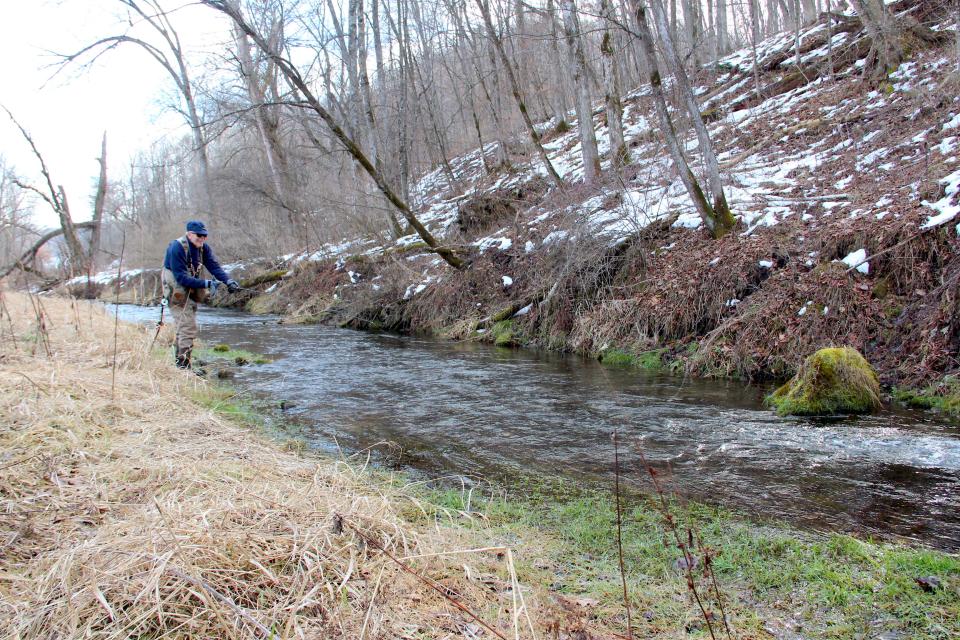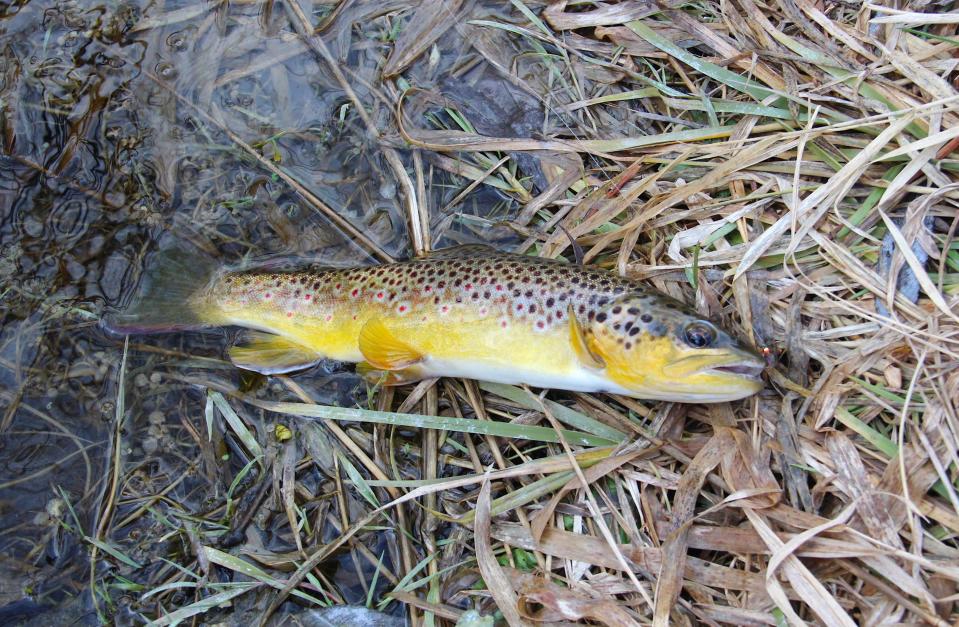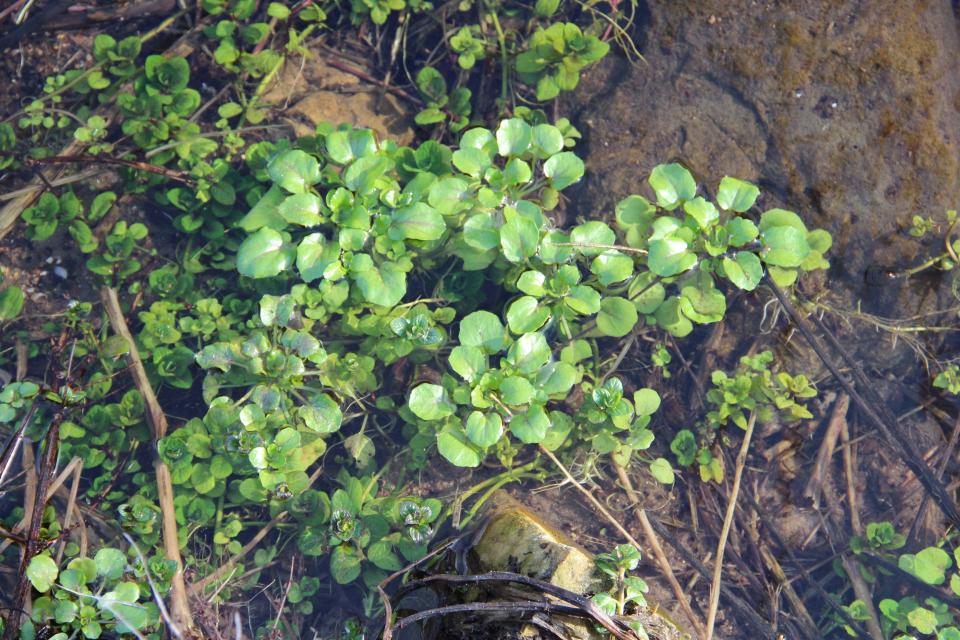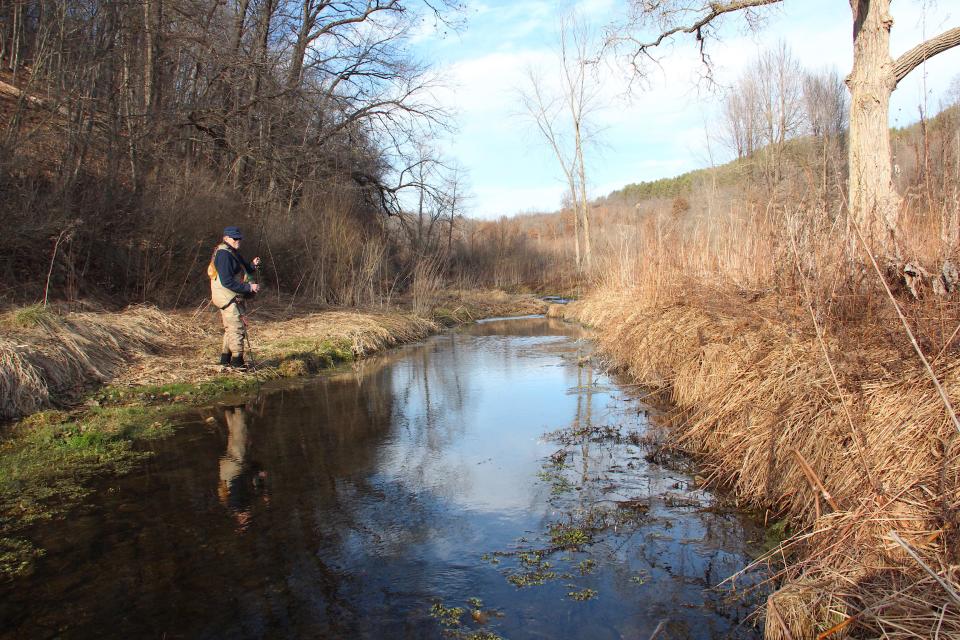Smith: Mild winter serves up sweet conditions for Wisconsin trout anglers in the Driftless Area

VIROQUA – Duke Welter of Viroqua stood on a sandy stream bank in the middle of a slice of Vernon County recreational heaven, also known as a public hunting and fishing ground.
Fly rod in hand, he took a quick glance over his right shoulder to look for trees or other potential obstructions, lifted the graphite wand with his left hand and with one deft movement flipped 20 feet of line upstream onto the riffling water.
A second later his indicator – a floating fly – was tugged under the surface, the sign of a strike.
Welter lifted the rod again, this time to the weight of a brown trout.
"Now that's exactly where a trout should be," Welter said. "Don't you just love it when a fish plays by the rules?"
After 30 seconds of to-and-fro Welter worked the 14-inch-long trout to hand, used a forceps to flip the fly out of its lip and watched it swim away.
It had hit a scud pattern, the dropper on his two-fly set-up.
"Your turn," Welter said, motioning me forward as if I were taking the next dance from a shared partner.
Welter and I have been friends for about 20 years and have fished together enough to know our fishing habits and preferences align.
When it comes to stream trout fishing, some pairs or groups of anglers opt to split up, go their separate ways and rendezvous later to tell stories.
Welter and I would rather stay together and share the experience. One person fishes a likely looking spot, then yields to the other at the next.
It lends to learning, yes, especially to the person who hasn't fished the location before. It also helps quicken the process of finding what flies or lures the fish are hitting.
But it's also more fun and offers plenty of opportunities for, as Welter likes to say, "spontaneous critique." The rest of the world would know it as heckling but there's no need to debate.
Welter has an undergraduate degree in journalism and a juris doctor degree, both from the University of Wisconsin. He worked for several years as a journalist, 28 as an attorney and then 12 as an outreach specialist for Trout Unlimited.
All of that is to say he's pretty good with words. I'll leave him to his definitions, I'll stick to mine.

Our latest trout outing was Feb. 6 on waters of the Driftless Area near Viroqua. We were partaking of Wisconsin's early catch-and-release trout season. This year the season runs Jan. 6 to May 3.
Anglers are required to artificial lures or flies. All fish caught must be immediately released.
The season is open on all streams in 46 counties (including all in the Driftless Area), almost all streams in four, and a smattering in 14. It's closed in eight counties in northeastern Wisconsin.
One look at the map in the Department of Natural Resources fishing regulation pamphlet and it's obvious the Driftless has a wealth of high-quality trout streams.
Vernon County, for example, is striped with dozens of trout streams, including Class 1 (high quality waters with sufficient natural reproduction to sustain populations of wild trout at or near carrying capacity) and Class 2 (streams with some natural reproduction and often some stocking).
Welter said when he moved to Viroqua from Eau Claire in 2013 he plotted a map of trout water within 30 miles of his front door.
He came up with 200 streams or sections of streams, including 40 exceptionally good ones.
Eleven years later he still hasn't fished all 40 at the top of his list.
"I've been working at it, really," Welter said. "It's not as easy as you might think."

The winter of 2023-24 is giving Welter, and all inland trout fishers, an assist.
The warmer than normal conditions have largely kept the streams ice-free and allowed anglers excellent access.
On Feb. 6 the sun shined through patchy white clouds and the mercury rose into the low 50s. Most of the streams ran moderate of flow and just a bit off color, a very fishable combination.
A few stretches were flanked by snow but most of Vernon County was brown. Except for the bright green of watercress growing in the spring creeks.
In fact Welter had made an exception to join me on the outing.
"I had a rule to not fish until late March," Welter said. "You made me break it."
Welter is one of the most skilled fly anglers I know. He also keeps pretty good records of his fishing experiences.
In years of fishing the early trout season, he said his catches in January and February were about the same as if he didn't go fishing.
To be sure, the normally cold conditions at the time aren't optimal for insect activity or trout feeding.
But this year is different. The streams we fished had water temps in the high 40s.
We made our way upstream, changing leads and offering color commentary of the other's efforts.
When I snagged my fly high in a streamside tree, Welter said "Oh, that's too bad."
"Sid Caesar once said if you could feign sincerity in Hollywood, you could find success," Welter said. "It's true on the stream, too."

Obstacles aside, the conditions were excellent for catching. We found willing trout at each likely spot. Welter, with his precious casting ability, out-caught me by a wide margin. All his fish were brown trout.
I happened to land the only brook trout of the outing, a stunningly colored 11-incher.
At 2 p.m. we saw fish rising to tiny midges and switched, with some success, to dry flies. Real-life snow flies also flitted along the snow-free banks.
We fished two stretches of different streams on the outing. Both were within 10 minutes drive from downtown Viroqua.
About 3:30 we decided to call it a day and hiked up out of the public fishing ground and back to the vehicle.
"Well, I don't know if I'll let you make me break my rule again, but this time it worked out OK," Welter said with a smile. "Just don't push your luck."
With good fishing conditions and the wealth of cold-water resources in the Driftless Area, I'll take my chances.
Help prevent spread of invasive species during Wisconsin's early trout season
The Department of Natural Resources reminds anglers out for the early inland trout season to help protect streams from aquatic invasive species. Some fishing streams contain invasive species, and if care is not taken, those species can accidentally be transferred to another, the DNR said in its statement.
New Zealand mudsnails have one of the highest potentials of spreading from one water to another. Just 4-6 millimeters in length, they can easily get stuck in the mud and picked up on boots, waders and gear. Felt-soled boots are particularly susceptible to these snails as they can lodge into and under the felt. The snails can lie in the mud along the shore, so they can be spread without ever stepping foot into the water.
In addition, seeds and fragments of some invasive plants can survive winter under the ice. Thoroughly cleaning fishing gear before leaving a fishing site can help stop the chance of spreading invasive species.
A few minutes of preventive action can help preserve and protect waterways for generations to come. Before leaving a fishing site, the DNR advises anglers to:
Inspect fishing equipment for attached aquatic plants, animals or mud.
Remove all attached plants or animals.
Drain all water from buckets and containers.
Never move live fish away from a waterbody.
To learn more about invasive species and their impacts on Wisconsin's waters, visit the DNR's Aquatic Invasive Species webpage.
This article originally appeared on Milwaukee Journal Sentinel: Wisconsin early catch-and-release trout fishermen helped by weather

